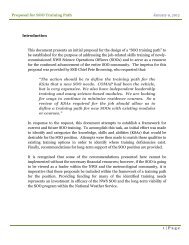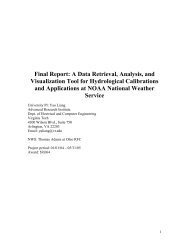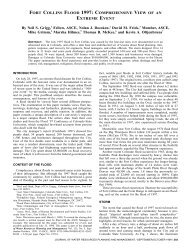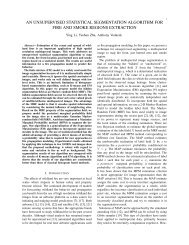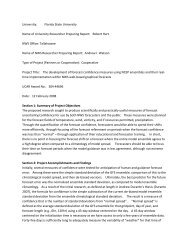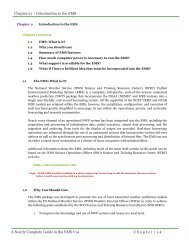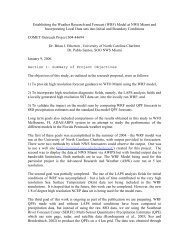satellite-based fire detection and mapping for the eastern ... - COMET
satellite-based fire detection and mapping for the eastern ... - COMET
satellite-based fire detection and mapping for the eastern ... - COMET
You also want an ePaper? Increase the reach of your titles
YUMPU automatically turns print PDFs into web optimized ePapers that Google loves.
EastFIRE SESSION 3C-2Table 1 - MODIS technical specifications (Source: NASA)INSTRUMENTTypeMulti-spectral cross track scanning radiometerView Angle 110 o (+/- 55 o from nadir)2,330 KM swath (cross track), 10 KM (alongSwathtrack)SpectralResolutionSpatialResolutionTemporalResolutionQuantization 12 bitsORBITTypeAltitudeInclinationEquatorialCrossingGENERALLaunch Date36 b<strong>and</strong>s (0.4 µm to 14.4 µm, Visible toThermal Infrared)2 @ 250 meters, Red/NIR (B<strong>and</strong>s 1 & 2)5 @ 500 meters, Visible to MIR (B<strong>and</strong>s 3 – 7)29 @ 1 KM, Visible to TIR (B<strong>and</strong>s 8 – 36)Once daily <strong>for</strong> collection of solar reflectiveb<strong>and</strong>s; Twice daily <strong>for</strong> collection of <strong>the</strong>rmalb<strong>and</strong>s (at latitudes greater than 30 degrees)Sun-synchronous, near polar orbit705 KM98.2 o degreesDesign Life 6 years10:30 a.m. descending node (Terra); 1:30 p.m.ascending node (Aqua)December 18, 1999 (Terra); May 4, 2002(Aqua)present on daytime versus nighttime observations(Giglio et al., 2003).Immediate access to MODIS imagery <strong>and</strong> derived<strong>fire</strong> <strong>detection</strong> locations is facilitated by <strong>the</strong> RapidResponse System (Descloitres et al., 2002)developed by GSFC <strong>and</strong> <strong>the</strong> University ofMaryl<strong>and</strong>. The Rapid Response System is anautomated image processing system that processesMODIS imagery <strong>and</strong> extracts <strong>fire</strong> <strong>detection</strong>locations <strong>and</strong> associated <strong>fire</strong> characteristics. Fire<strong>detection</strong> processing in <strong>the</strong> Rapid Response Systemuses <strong>the</strong> same algorithm utilized by <strong>the</strong> MODISAdaptive Processing System (MODAPS) toproduce <strong>the</strong> MOD14 Fire <strong>and</strong> Thermal Anomaliesproduct (National Aeronautics <strong>and</strong> SpaceAdministration, 2005). The MOD14 product isavailable from <strong>the</strong> L<strong>and</strong> Processes DistributedActive Archive Center (LP-DAAC) within days ofMODIS image data acquisition; however, thisdelay minimizes its use <strong>for</strong> operational <strong>fire</strong><strong>detection</strong> <strong>and</strong> monitoring.As <strong>the</strong> data source <strong>for</strong> <strong>the</strong> MODIS Active FireMapping Program, Rapid Response operates as adistributed system. The main Rapid ResponseSystem is located at GSFC <strong>and</strong> processes near realtimeMODIS data (2-4 hours post-acquisition) <strong>for</strong><strong>the</strong> entire United States. This raw image data ismade available to <strong>the</strong> GSFC Rapid ResponseSystem via a bent pipe feed from <strong>the</strong> NOAAMODIS Near Real Time Processing System. Inaddition to <strong>the</strong> main Rapid Response System, <strong>the</strong>reare several instances of <strong>the</strong> Rapid Response Systemresiding at MODIS direct readout ground stationsthroughout <strong>the</strong> United States. MODIS directreadout ground stations collect daily real-timeMODIS data <strong>for</strong> substantial portions of <strong>the</strong>country. MODIS image data are continuouslybroadcast directly from both MODIS sensors as<strong>the</strong>y orbit overhead. Ground stations can collectraw image data broadcast by MODIS whilemaintaining line of sight visibility to <strong>the</strong> sensor.These real-time MODIS data are immediatelyprocessed to extract <strong>fire</strong> locations using <strong>the</strong> RapidResponse System on site.For <strong>the</strong> MODIS Active Fire Mapping Program,real-time MODIS <strong>fire</strong> <strong>detection</strong> data coverage <strong>for</strong><strong>the</strong> <strong>eastern</strong> as well as <strong>the</strong> western United States isfacilitated by MODIS direct readout groundstations managed by RSAC in Salt Lake City, Utah<strong>and</strong> <strong>the</strong> Space Science <strong>and</strong> Engineering Center(SSEC) at <strong>the</strong> University of Wisconsin in Madison,Wisconsin. Raw <strong>fire</strong> <strong>detection</strong> data produced by<strong>the</strong> Rapid Response System at GSFC <strong>and</strong> RSAC<strong>and</strong> SSEC ground station facilities are continuouslyintegrated into <strong>the</strong> MODIS Active Fire MappingProgram at RSAC. The near real-time <strong>fire</strong><strong>detection</strong> data provided by GSFC augments <strong>the</strong>real-time data provided by <strong>the</strong> MODIS groundstations <strong>and</strong> serves as a alternative data sourcewhen necessary.3. MODIS ACTIVE FIRE MAPPINGPRODUCTS FOR THE EASTERN UNITEDSTATESRaw <strong>fire</strong> <strong>detection</strong> data are compiled <strong>and</strong> processedby <strong>the</strong> MODIS Active Fire Mapping Program toprovide several value-added geospatial products 24hours daily, year round. The operational productsprovide a comprehensive assessment of <strong>the</strong> current<strong>fire</strong> activity <strong>and</strong> extent <strong>for</strong> <strong>the</strong> <strong>eastern</strong> UnitedStates, <strong>and</strong> <strong>the</strong> rest of <strong>the</strong> country, <strong>based</strong> on <strong>the</strong>most recent MODIS observations.MODIS Active Fire Mapping products areintended <strong>for</strong> use at regional <strong>and</strong> national scales.The products can also be used with local <strong>fire</strong>in<strong>for</strong>mation (e.g. Incident Status SummaryDatabase (ICS209), National Fire Plan Operations<strong>and</strong> Reporting System, etc.) to provide contextual
EastFIRE SESSION 3C-2in<strong>for</strong>mation. The integration of MODIS <strong>fire</strong><strong>mapping</strong> products with various sources of ancillaryin<strong>for</strong>mation facilitates an integrated decisionsupport system <strong>for</strong> <strong>the</strong> management of wild<strong>fire</strong> <strong>and</strong>prescribed <strong>fire</strong> activity. Notable MODIS ActiveFire Mapping Program geospatial productsprovided <strong>for</strong> <strong>the</strong> <strong>eastern</strong> United States include <strong>the</strong>following:Hardcopy Fire Detection Maps- Digital versions ofregional scale hardcopy maps displayingcumulative <strong>and</strong> recent MODIS <strong>fire</strong> <strong>detection</strong>activity (Figure 2). 21 poster-size maps –including nine maps covering <strong>the</strong> area of <strong>the</strong>United States east of <strong>the</strong> Mississippi River - areupdated up to four times daily after local MODISobservations as <strong>fire</strong> conditions warrant.Interactive Fire Detection Map- Web-<strong>based</strong>,interactive <strong>fire</strong> <strong>detection</strong> <strong>mapping</strong> application <strong>for</strong><strong>the</strong> continental United States. Users can pan/zoomto a user-specified scale <strong>and</strong> integrate currentMODIS <strong>fire</strong> <strong>detection</strong> data with various map layers(Figure 3). MODIS <strong>fire</strong> <strong>detection</strong> data are updatedhourly <strong>and</strong> are provided in conjunction with <strong>fire</strong><strong>detection</strong> data provided by NOAA NESDIS fromo<strong>the</strong>r high temporal sensors (McNamara et al.,2002). MODIS <strong>fire</strong> <strong>detection</strong> data compiled <strong>and</strong>processed by <strong>the</strong> MODIS Active Fire MappingProgram are also relayed to o<strong>the</strong>r web-<strong>based</strong>, <strong>fire</strong>support <strong>mapping</strong> services including GeoMAC(http://geomac.usgs.gov).Figure 2 - Recent <strong>and</strong> cumulative year 2005 MODIS <strong>fire</strong> <strong>detection</strong> activity <strong>for</strong> sou<strong>the</strong>rn Georgia <strong>and</strong> Alabama <strong>and</strong> nor<strong>the</strong>rnFlorida on April 21, 2005. MODIS <strong>fire</strong> <strong>detection</strong>s in <strong>the</strong> last 12 hours are depicted in red; last 24 hours in orange, <strong>and</strong>previous <strong>detection</strong>s in yellow.Figure 3 - Web-<strong>based</strong>, interactive MODIS <strong>fire</strong> <strong>detection</strong> maps display <strong>fire</strong> <strong>detection</strong> data with user-selected map layers at userdefinedmap extents <strong>and</strong> scales.
EastFIRE SESSION 3C-2Fire Detection GIS Data – Hourly updates ofcumulative 1 kilometer MODIS <strong>fire</strong> <strong>detection</strong>datasets <strong>for</strong> <strong>the</strong> entire United States. Current <strong>and</strong>historical GIS datasets include attribute fieldsdescribing <strong>fire</strong> characteristics <strong>and</strong> are compiledfrom MODIS Rapid Response output at GSFC <strong>and</strong>MODIS ground stations. These MODIS <strong>fire</strong><strong>detection</strong> GIS datasets are also mirrored at <strong>the</strong>Geospatial One Stop (http://www.geodata.gov).Fire Detection Summaries – Cursory map <strong>and</strong>tabular summaries describing <strong>the</strong> most recentindividual MODIS <strong>fire</strong> <strong>detection</strong> locations <strong>for</strong> <strong>the</strong>United States.4. FUTURE OF THE PROGRAMIn preparation <strong>for</strong> <strong>the</strong> post-MODIS era, <strong>the</strong> MODISActive Fire Mapping Program is preparing toleverage <strong>the</strong> next generation of moderate resolutionsensors capable of <strong>fire</strong> <strong>detection</strong> <strong>and</strong> monitoring. Itis anticipated that future sensors will provide <strong>fire</strong><strong>detection</strong> data at relatively higher spatial resolution<strong>and</strong> assess additional characteristics about observed<strong>fire</strong> activity.Currently, RSAC is making preparations toleverage <strong>the</strong> Visible/Infrared Imager/RadiometerSuite (VIIRS) in <strong>the</strong> near future. VIIRS is afollow-on sensor to <strong>the</strong> Advanced Very HighResolution Radiometer (AVHRR) <strong>and</strong> will fly on<strong>the</strong> National Polar-Orbiting EnvironmentalSatellite System (NPOESS). The first NPOESS<strong>satellite</strong> will be launched in 2009 preceded by <strong>the</strong>launch of an EOS-NPOESS bridging mission, <strong>the</strong>NPOESS Preparatory Project (NPP), in late 2006.The VIIRS instrument onboard NPP <strong>and</strong> NPOESSis anticipated to collect global <strong>fire</strong> <strong>detection</strong> data ata spatial resolution of 750 meters. With a plannedconstellation of three NPOESS <strong>satellite</strong>s orbiting<strong>the</strong> Earth by 2013, VIIRS will provide six daily<strong>the</strong>rmal observations <strong>for</strong> <strong>fire</strong> <strong>detection</strong> <strong>and</strong>monitoring.5. ACKNOWLEDGEMENTSThe author wishes to acknowledge several entitiesthat help make <strong>the</strong> USDA Forest Service MODISActive Fire Mapping Program possible. Theseentities include NASA Goddard Space FlightCenter <strong>and</strong> <strong>the</strong> University of Maryl<strong>and</strong> <strong>for</strong> <strong>the</strong>development <strong>and</strong> implementation of <strong>the</strong> RapidResponse System; <strong>the</strong> NOAA MODIS Near RealTime Processing System <strong>for</strong> providing access to<strong>the</strong> near real-time MODIS data stream; <strong>and</strong>, <strong>the</strong>University of Wisconsin Space Science <strong>and</strong>Engineering Center <strong>and</strong> <strong>the</strong> University of Alaska-Fairbanks Geographic In<strong>for</strong>mation Network ofAlaska (GINA) <strong>for</strong> providing access to real-timeMODIS imagery <strong>and</strong> <strong>fire</strong> location data.6. REFERENCESDescloitres J., R. Sohlberg, J. Owens, L. Giglio, C.Justice, M. Carroll, J. Seaton, M. Crisologo,M. Finco, K. Lannom, <strong>and</strong> T. Bobbe, 2002:The MODIS L<strong>and</strong> Rapid Response project.IGARSS: IEEE International Geoscience<strong>and</strong> Remote Sensing SymposiumProceedings, Toronto, 2002.Giglio, L., Descloitres, J., Justice, C. O., <strong>and</strong> Kaufman,Y. J., 2003: An enhanced contextual <strong>fire</strong><strong>detection</strong> algorithm <strong>for</strong> MODIS. RemoteSensing of <strong>the</strong> Environment, 87, 273-282.McNamara, D., G. Stephens, B. Ramsay, E. Prins, I.Csiszar, C. Elvidge, R. Hobson, <strong>and</strong> C.Schmidt, 2002: Fire Detection <strong>and</strong>Monitoring Products at <strong>the</strong> National Oceanic<strong>and</strong> Atmospheric Administration.Photogrammetric Engineering <strong>and</strong> RemoteSensing 68, 774-775.National Aeronautics <strong>and</strong> Space Administration, 2005:MODIS Fire <strong>and</strong> Thermal Anomalies Guide.Online technical reference, accessed April18, 2005. URL: http://modis-<strong>fire</strong>.umd.edu.National Interagency Coordination Center, 2005:National Interagency Coordination Center2004 Statistics <strong>and</strong> Summary. AccessedApril 15, 2005. URL:http://www.nifc.gov/news/2004_statssumm/2004Stats&Summ.html.7. AUTHOR BIOGRAPHYBrad Quayle is a remote sensing/geographicin<strong>for</strong>mation system specialist in <strong>the</strong> OperationsProgram of <strong>the</strong> USDA Forest Service RemoteSensing Applications Center in Salt Lake City,Utah. At RSAC, he manages <strong>the</strong> MODIS ActiveFire Mapping Program <strong>and</strong> utilizes MODIS <strong>and</strong>o<strong>the</strong>r <strong>satellite</strong> sensors to support o<strong>the</strong>r aspects ofwild<strong>fire</strong> management, <strong>and</strong> resource inventory <strong>and</strong>assessment objectives.



